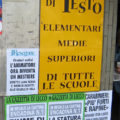Another Battisti classic.
| Hai ragione anche tu cosa voglio di più un lavoro io l’ho una casa io l’ho la mattina c’è chi mi prepara il caffè questo io lo so e la sera c’è chi non sa dirmi no cosa voglio di più hai ragione tu cosa voglio di più cosa voglio Anna voglio Anna Non hai mai visto un uomo piangere apri bene gli occhi sai perché tu ora lo vedrai apri bene gli occhi sai perché tu ora lo vedrai se tu non hai mai visto un uomo piangere guardami guardami Anna voglio Anna Ho dormito lì fra i capelli suoi io insieme a lei ero un uomo quanti e quanti sì ha gridato lei quanti non lo sai ero un uomo Cosa sono ora io cosa sono mio Dio resta poco di me io che parlo con te io che parlo con te di Anna Anna voglio Anna |
You, too, are right What more do I want? I have a job I have a home In the morning there is someone who makes my coffee I know this. And in the evening there is someone who Can’t say no to me What more do I want? You’re right. What more do I want? What do I want? Anna. I want Anna. You’ve never seen a man cry open your eyes wide, you know, because now you will see him/it open your eyes wide, you know, because now you will see him/it if you’ve never seen a man cry look at me look at me Anna. I want Anna. I slept there among her hair together with her I was a man How many “yeses†she cried out You don’t know how many I was a man What am I now? My god, what am I? There’s little left of me I who speak with you I who speak with you of Anna. Anna. I want Anna. |














